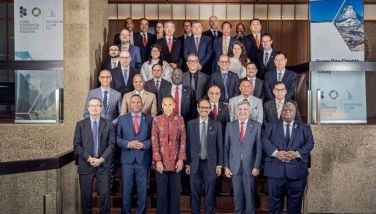Fault Finder
MANILA, Philippines - “We need more fault finders.”
The Philippines’ top volcanologist and earthquake expert Renato Solidum, Jr. wants everyone involved in making sure the country is prepared when the Big One strikes.
Solidum, who heads the Philippine Institute of Volcanology and Seismology (Phivolcs) since 2003, refers specifically to the scientists who have the capability of identifying earthquake generators.
“We have determined the major faults, but there can be minor faults that we don’t know about, because some faults do not appear at the surface and they move below and generate earthquakes,” Solidum explains to STARweek.
The 48-year-old Phivolcs chief cites the magnitude-6.3 earthquake that hit Christchurch in New Zealand last Feb. 23 which killed almost 200 people, including Filipinos. He says there was no active fault identified in the area where the earthquake happened.
Some foreign experts have noted that in the case of the magnitude-9.0 earthquake that struck near Honshu, Japan last March 11, the Japanese authorities focused their attention too much on other areas they believe were at high risk to powerful earthquakes.
 Renato Solidum (in orange) briefs media on the condition of the restive Mayon volcano.
Renato Solidum (in orange) briefs media on the condition of the restive Mayon volcano. The powerful earthquake triggered a massive tsunami that killed over 10,000 people and damaged the Fukushima Dai-ichi nuclear power plant, causing fears of radiation around Pacific rim countries, including the Philippines which is just 3,010 kilometers away.
Solidum says he hopes more young Filipinos will study geology. “We hope to attract more people who will go into that field. We have enough but we need more to make the work faster because the demand is getting faster and faster and faster,” he says.
“In reality we have enough data already but what we need to do is to go down to the details because since we are studying earthquakes, why not try to predict an earthquake in the future. We hope to do that but we have to do a lot of research,” Solidum says.
Phivolcs officials had warned Metro Manila residents about a magnitude-7.2 earthquake that could likely happen at any moment. The strong earthquake could be generated by the West Valley Fault System (formerly Marikina Valley Fault) which, according to experts, is ripe for another major movement.
Based on a 2004 study done by Phivolcs, an earthquake of that magnitude will affect about 40 percent of residential buildings in Metro Manila – 170,000 homes will collapse and 340,000 will be damaged, and the death toll could reach 34,000. An additional 18,000 people will die from fires that will spread after the earthquake, for a total casualty of 52,000.
The study found that the fault moves every 200 to 400 years, and its last major movement occurred over 200 years ago.
The West Valley Fault starts from the Sierra Madre mountains and runs through Bulacan, Rodriguez, Rizal, Quezon City, the eastern side of Metro Manila including Pasig, Taguig, Muntinlupa, San Pedro, and Sta. Rosa in Laguna and ends in Carmona, Cavite.
Solidum emphasizes the need for every individual to prepare for strong earthquakes, even those whose houses or properties are not built near or above an active fault.
“If one would only look for a fault that would give a wrong message that only people very near the fault should prepare, that is wrong,” Solidum says.
Solidum says the only area that is safe from earthquake in terms of ground shaking is the province of Palawan because there is no active fault there.
“But people in Palawan should also prepare because other hazards brought about by an earthquake like tsunami might affect them. Everyone should prepare,” he emphasizes.
“The Philippines being transected by active faults and bounded by trenches – which are places where the plates or blocks of rocks in the ocean would dive under – make the country really prone to strong earthquakes,” Solidum explains.
 Modern technology has enabled Solidum and Philvolcs to more accurately map and study volcanoes and earthquakes. walter bollozos/star
Modern technology has enabled Solidum and Philvolcs to more accurately map and study volcanoes and earthquakes. walter bollozos/star According to Solidum, the Philippines has been affected by 90 destructive earthquakes in the past 400 years. Some of these strong quakes occurred offshore and generated tsunamis.
“There were around 40 tsunamis (that affected the country) for the past 400 years and at least a dozen were destructive,” he says.
The most destructive was the August 17, 1979 earthquake-triggered tsunami that hit the Moro Gulf in Mindanao which left nearly 4,000 people dead and close to 8,000 others injured.
While earthquakes cannot be predicted, the Phivolcs head underscores the importance of preparedness and response during disasters.
Solidum explains that earthquake preparedness must be done on four levels – structural, individual, community and government.
First is making sure that buildings and other infrastructure can resist severe ground shaking.
According to the licensed geologist, buildings that follow the National Building Code could withstand strong tremors. The National Building Code was established in 1972 after the Ruby Tower collapse. In 1968, a magnitude-7.3 quake in Casiguran, Aurora caused the six-story Ruby Tower in Manila to collapse, killing 268 people.
“Our building code is good and is modified from time to time and those who follow the code are quite resistant to strong earthquakes,” Solidum says.
 Advocating community preparedness takes Solidum around the country, as he is shown discussing hazard maps with residents living near Taal Volcano.
Advocating community preparedness takes Solidum around the country, as he is shown discussing hazard maps with residents living near Taal Volcano. The second level is individual preparedness.
“One must know what to do before, during and after an earthquake, one must know how to react properly,” he says.
“You have to make sure that your workplace and house are ready – simple things like anchoring cabinets, making sure that things on the ceiling are tightly anchored, and look for places where you can hide during an earthquake and then look for a place where they will evacuate after an earthquake. That is individual preparedness,” Solidum says, adding that the public must take earthquake drills seriously.
People must also prepare an emergency kit which includes food, water, spare clothes, blanket, flashlight, rope, whistle for signaling in an emergency, transistor radio, and first-aid medicine.
“Look for safer spots in the house or building. If there is a sturdy table that is one place that you can go. Do the duck, cover and hold approach – hold the legs of the table so it will not move or you move along with the table if you cannot hold the table in position,” he says.
The third level is community preparedness.
“During a strong earthquake the community should not expect help right away because the damage could be widespread, so we need to make sure that the community is prepared,” he says.
“They need to have an earthquake preparedness and response plan such as conducting drills, creating first aid teams and search and rescue teams. They need to have proper information management, to act on the right information, not from rumors or hoax messages,” he adds. The fourth level of preparedness is done by the government.
“The government must implement rules, the building code and the land use plan, and each one of us as citizens should follow them,” Solidum says.
Earthquake preparedness has been an advocacy of his office since the seismology function was transferred from the Philippine Atmospheric, Geophysical and Astronomical Services Administration (PAGASA) to Phivolcs in 1987.
 Advanced equipment like digital seismographs and earthquake intensity meters enhance Philvolcs’ work.
Advanced equipment like digital seismographs and earthquake intensity meters enhance Philvolcs’ work. “We do a lot of print materials we have been distributing for the past several years,” he says.
Phivolcs has been conducting tsunami drills with the Office of the Civil Defense, and partnered with the Department of Education for the conduct of earthquake drills in schools every quarter.
“We are also developing tools that will help not only the common people but also the disaster managers and development planners to integrate disaster risk reduction in the development planning of a community,” Solidum says.
I did not plan to be a geologist. I wanted to be a civil engineer when I was in high school and I indicated my preferred program as civil engineering when I took the entrance examination at the University of the Philippines, Diliman. The acceptance letter from UP indicated that I was accepted to register at UP but I needed to enroll in a non-quota course during my first year and then apply to my desired program after,” he shares.
“During the day of my scheduled registration, the block sections for freshmen without specific degree programs were filled up right away. I had to review the offered non-quota programs which still had open slots, and I chose geology. I liked what I learned about geology during my first year and decided to stick with it,” Solidum says.
After graduationin 1984, Solidum planned to work in the private sector in geothermal, oil or mineral exploration. But he was immediately hired at Phivolcs upon the recommendation of his professor, former Phivolcs director the late Dr. Raymundo Punongbayan.
“I was challenged by Dr. Punongbayan to work with government at Phivolcs to serve the country. He also said that although the salary is not significant I would have the opportunity to get advance degrees. I decided then that I will work at Phivolcs to focus on studying volcanoes and subsequently earthquakes so that our communities will be safer from impacts of volcanic eruptions and earthquake occurrences and their related hazards,” Solidum says.
Solidum completed a master’s degree in Geological Sciences at the University of Illinois in Chicago in 1992.
In 2002, Solidum obtained a doctorate degree in Earth Sciences at the Scripps Institution of Oceanography at the University of California in San Diego.
Today at Phivolcs, Solidum leads the agency not only in monitoring and warning of potential threats of earthquakes, eruptions, and tsunamis, but also in assessing hazards and risks, doing research and development, and bringing the scientific information they produce to the people.
Solidum says Phivolcs scientists are equipped with state-of-the-art equipment like the digital seismograph. The agency has also developed its own software called the Rapid Earthquake Damage Assessment System (REDAS), which maps earthquake intensity and its possible effects.
“We might not know where the most hit areas are so we can simulate that and be able to respond properly. The REDAS can also simulate where the liquefaction, landslide might occur, and if there will be a tsunami what time the tsunami will arrive and what is the possible height. Now this has also the capacity to model the potential impact for a given scenario earthquake so you can plan ahead and prepare your contingency plan,” Solidum says.
Phivolcs is also adding more seismic stations in the country. To date, the agency has 66 manned and unmanned stations that monitor seismic activities all over the country. Aside from these, the agency is deploying 100 earthquake intensity meters all over the country.
Unlike the other threats, earthquakes cannot be predicted. This is why it is important to be prepared at all times.
“Preparedness should be everyone’s business. It should be done by at home, in companies, other organizations – all of us should be prepared,” Solidum emphasizes.
- Latest
- Trending















